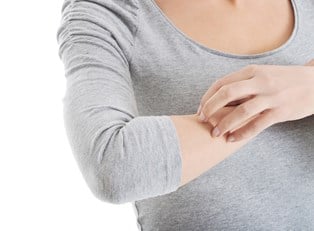Eczema is a chronic skin disorder that involves itchy rashes and skin inflammation. This term is actually a way to describe many different types of skin swelling.
There can be many factors that can cause this disorder. These factors may include irritating substances, allergies, genetics, and other diseases. People with this rash often have a family history of this condition or related conditions such as asthma or hay fever. Eczema has never been known to be contagious. Though it has not been proven, many doctors believe that this skin condition may be most commonly associated with excrement from dust mites.
The different types of eczema can be classified by the different locations on the body where it is found or the possible cause of eczema. Getting all the eczema information that you can is the best way to begin to try to diagnose and treat eczema. Eczema is not considered dangerous, but it can be very irritating and annoying. This skin disorder is most common in children and sometimes infants. About 80% of those affected begin to see symptoms before the age of five. You can avoid some types of these rashes by avoiding irritants, stress, and the things you may be allergic too.
Seven Types
There are seven known types of eczema. This type of eczema information is important as it can determine the course of action that is to be taken. These different kinds can also be referred to as dermatitis as well. Atopic dermatitis is probably the most common type; almost every other type has similar symptoms to this type. This is a chronic disease that causes itchy and inflamed skin. This type is also identified by it likeliness to come and go. There are many factors that cause atopic dermatitis such as pollen, soaps, detergents, perfumes and other allergies. The next type is referred to as contact dermatitis.
This type is a localized reaction to allergens that includes redness, itching, and burning. This reaction is usually caused by an allergen or a general irritant such as an acid or a cleaning agent. This skin disorder is sometimes called allergic contact dermatitis. Seborrheic is a form of skin inflammation of an unknown cause. The symptoms of this skin disorder may include yellowish, oily, or scaly patches of skin. Dandruff and cradle cap are prime examples of this type. Nummular is characterized by small, round patches of irritated skin. This is most commonly found on the arms, legs, and buttocks. Neurodermatitis is a chronic skin swelling caused by scratching an infected area, such as an insect bite, that becomes extremely irritated when touched. Stasis dermatitis is a skin disorder that is found on the lower legs and is generally related to circulatory problems.
This happens because the valves within the veins have been compromised. This can lead to blistering, oozing, skin lesions, and unsightly ulcers. The final type of disorder is disherdritic dermatitis. The skin disorder is localized on the palms of the hands and the soles of the feet. These are clear blisters that itch and burn. This can be more common in the summer and spring months. Primarily in warm weather.
Prevention and Treatment
One of the most important things to learn when it comes to eczema information is the prevention and treatment of the skin disorder. The purpose of treatment is to prevent itching, inflammation, and spreading of the rash. Prevention not only requires medication but a change in lifestyle as well. The first step that should be taken is prevention. This includes getting as much eczema information as possible as this will give you a better idea of what type of prevention is necessary. Bathing every other day instead of every day is a great way to prevent eczema.
When you do bath it is important to apply moisturizer or creams on an area that is usually prone to infection. Another tip for prevention during bathing is to switch to a mild hypoallergenic soap and avoid water that is too hot. Unknown irritants such as jewelry, laundry detergents, and certain cleaning agents should be avoided at all costs. Since stress plays a factor in this disorder, meditation and exercise can help in prevention. If prevention is unsuccessful the next step is treatment. Knowing the different types of treatments is excellent eczema information to help deal with this disorder. Cold compresses can help with swelling and itching.
Medication is an often used treatment for the skin disorder. Tacrolimus and pimecrolimus are the two FDA approved creams available to sufferers. Oral medication such as antihistamines and hydroxyzine seem to be the most effective medications for relief. While this condition is an extremely irritating disorder, proper research of eczema information can lead to a normal lifestyle and help prevent many of the effects. As always a doctor visit is recommended before deciding on any diagnoses or treatment method.





